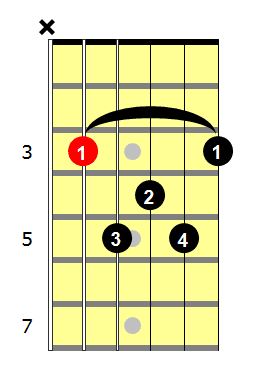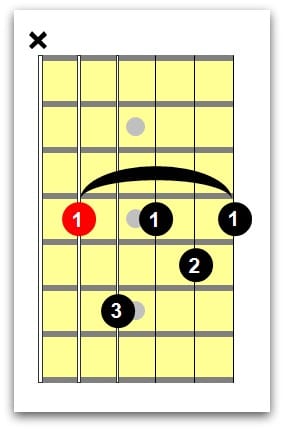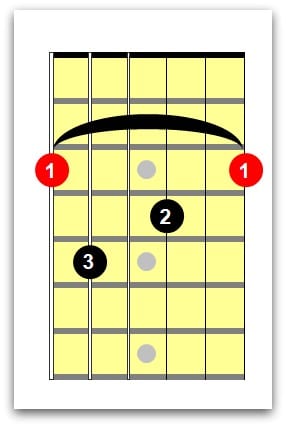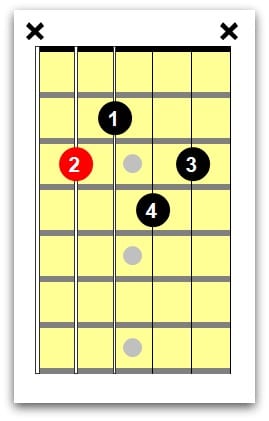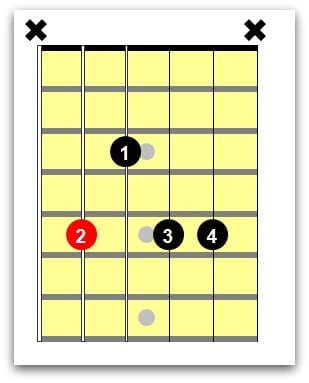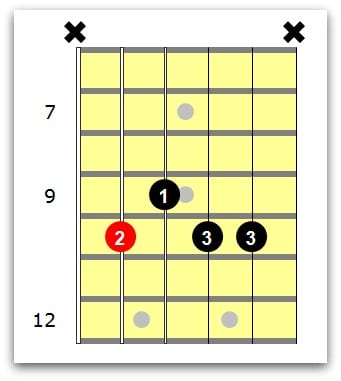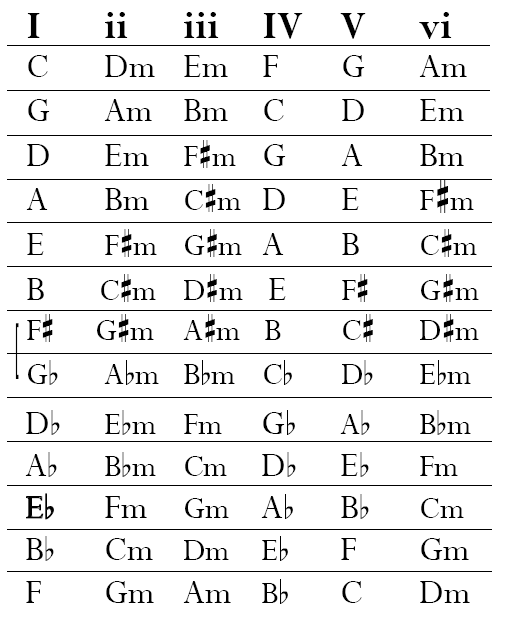Looking for advanced guitar lessons? Then you’re in the right place!
In this free guide you will learn:
-
- The secret to becoming an advanced guitarist.
- 6 essential chord shapes that every guitarist must know.
- 3 advanced guitar scales which will make you sound amazing.
- 2 super easy ways to enhance your rhythm and musicality.
Over 250,000 guitar-learners get our world-class guitar tips & tutorials sent straight to their inbox: Click here to join them
The guitar world can be understood in four quarters.
- Chords
- Scales and Lead
- Rhythmic Techniques
- Musical Theory
In this advanced guitar lessons we’re going to show you some essential lessons that you must know if you want to become an advanced guitarist.
Advanced Guitar Lessons | Guitar Chords
Advanced guitarists must know how to play the following chords :
- Major 7 Chords
- Minor 7 Chords
- Dominant 7 Chords
- Major 9 Chords
- Minor 9 Chords
- Dominant 9 Chords
These chords are far more harmonically advanced than your standard major and minor chords.
Want to add a level of sophistication to your playing? These chords are the answer.
Let’s learn some essential advanced guitar lessons about chords.
The Major 7 Chord
Here’s the chord box for a C major 7.
This chord is often heard in pop, soul, funk and jazz! It’s one of the most versatile chords you can learn.
The Minor 7 Chord
Here’s the chord box for a D minor 7.
You may have come across this chord if you’re into funk and soul.
The Dominant 7 Chord
Here’s the chord box for a G7 chord.
If you’ve ever played a 12 bar blues, you would have heard this chord.
The Major 9 Chord
The major 9 chord is a more advanced version of the major 7 chord.
Here’s the chord box:
The Minor 9 Chord
The minor 9 chord sounds deep and rich!
Here’s the chord box:
The Dominant 9 Chord
This chord is used frequently in funk music.
Here’s the chord box.
When can I use these chords?
Here’s a really cool trick that you can use to spice up ANY chord progression.
Any time you see a major chord, you could try a:
- Major 7
- Major 9
- Dominant 7
- Dominant 9
Any time you see a minor chord, you can try a:
- Minor 7
- Minor 9
A lot of the time this trick works. However some chord changes can sound a little weird.
As a rule, ALWAYS trust your ears.
If something sounds great, it is great!
If it doesn’t sound good, try a different chord.
In music, there is no wrong or right other than what sounds good!
What sounds good can vary greatly between different genres.
Changing The Chords
Let’s try an example to put this concept into action.
Here’s a standard progression, here we’ve used basic major and minor chords.
D Minor | G Major | C Major | A Minor
If we were going to change these chords to 7 chords, here’s what we’d do.
D Minor 7 | G7 | C Major 7 | A Minor 7
If we were going to change these to 9 chords, the progression now becomes.
D Minor 9 | G9 | C Major 9 | A Minor 9
The best way to integrate these new chords into your playing is to try and use them as much as possible.
Every time you see a major chord, sub it out for a major 7, or dominant 7.
Or if you see a minor chord, use a minor 7 or minor 9.
The more you do this, the more you’ll become comfortable with these new chords.
NB: Diatonically, chord 1 and chord 4 of a key are major 7s and chord 5 is a dominant 7. This doesn’t mean we have to stick to this as a rule. Blues for example often has all 3 major chords as dominant 7s, but it is useful to know.
How do I play chords in ALL keys?
To play chords in all keys, you MUST change the root note.
The root note is the first note in the chord.
As a few of the voicings of these chords are on the E and A string, we must know what the root notes are on both of these strings.
Here are the root notes on the low E string.
Here are the root notes on the A string.
To change the key of your chord, simply move it to a different root note.
So for example, if you wanted to play a major 7 chord in the key of Bb with the root note on the E string.
- Move it to the 6th fret.
Or, if you wanted to play a minor 9 chord in the key Db on the A string.
- Move your shape to the 4th fret.
This works for ANY chord. All you have to know is where the root notes are!
Download our lead guitar cheat-sheet to make things easier
It's hard to understand which scales work with which keys.
So we created a cheat-sheet! A key and scale-finder that you can use again and again.

Get your personalised guitar-learning plan 🎸
Get a custom guitar-learning plan here: Click here for GuitarMetrics™
World-Class Guitar Courses 🌎
Learn from the world's best guitar educators: Click here for our guitar courses
Advanced Guitar Lessons | Guitar Scales
If you want to become an advanced guitarist, you must learn more than your standard major and minor pentatonics.
Don’t know these scales? Go here: Learn Guitar Scales In 8 Easy Steps
In this advanced guitar lessons we’re going to learn the following scales:
- The Major Scale
- The Minor Scale
- The Dorian Scale
- The Mixolydian Scale
The Major Scale (the Ionian mode)
Here’s the tab for the major scale in the key of C.
Scales help you play lead guitar, to learn lead guitar go here: How To Play Lead Guitar
The Minor Scale (the Aeolian mode)
Here’s the tab for the minor scale in the key of A minor.
Want to learn more scales like this? Go here: Jazz Guitar: A 5-Step Programme For Rapid Jazz Skill
The Dorian mode
Here’s the tab for the Dorian scale in the key of D minor.
The Mixolydian mode
Here’s the tab for the mixolydian scale in the key of G.
Learning guitar scales can turn you into a shred demon, check out this article by Guitar Player which shows you 5 awesome guitars for the advancing guitarist: Roundup: 5 Shred Guitars Reviewed
When can I use these scales?
In music, there’s broadly two scale types.
- Major
- Minor
The standard major scale (also called the Ionian mode) and the Mixolydian mode are both major scales, however:
- The Ionian mode matches up with chord 1 of a key
- The Mixolydian mode matches up with chord 5 of a key
So, if a song is in the key of C and it starts on a chord of C, then you could use the C Ionian mode.
If a song is in the key of C, but it starts on a chord of G, then you could use the G Mixolydian mode.
For minor keys, you can use the following scales.
- The Dorian mode
- The Minor Scale (the Aeolian mode)
The Dorian mode matches up to chord 2 of a key.
The ordinary minor scale (also called the Aeolian mode) matches up to chord 6 of a key.
So if a song is in C, but it starts with a Dm chord you could use the D Dorian mode.
If a song is in C, but it starts with an Am chord, you could use the A Aeolian mode.
Not sure which chords are in which keys?
Not to worry. Here’s a handy chart to help you:
Not all music is strictly diatonic (ie. strictly adherent to the confines of the key) so feel free to experiment with different scales and see what sounds you can create.
You may find you like the sound of a Dorian mode against chord 6 rather than chord 2 for example.
Some genres thrive on this clashing of notes.
Get our best guitar tips & videos
Where should we send it?

